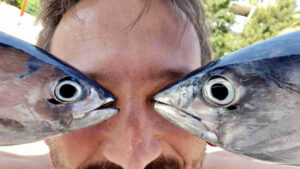He’s baaack!
Fresh from founding and listing immune-oncology play Chimeric, Paul Hopper can add Radiopharm Theranostics (ASX:RAD) to his boardroom rota after the nuclear medicine play listed on the ASX on Thursday – albeit limply.
The country’s busiest life sciences entrepreneur has now been responsible for founding or seeding six cancer-related, ASX-listed outfits, the other four being Imugene, Kazia Therapeutics, Prescient Therapeutics and Patrys Ltd.
He also chairs the spray mist drug delivery house Aravella Therapeutics, formerly Suda Pharmaceuticals.
Hopper says he didn’t know much about targeted radio isotopes but his interest was piqued by the 2018 listing of Dr Chris Behrenbruch’s Telix Pharmaceuticals.
In 2019, Novartis bought Advanced Accelerator Applications for $US3 billion ($4.1 billion) and then six months later snaffled Endocyte for $US2 billion.
“There was an outbreak of takeover activity and I thought this could be an interesting sector,” he says.
As its contrived ‘theranostics’ moniker implies, the company is developing diagnostic and therapeutic radiopharmaceuticals for cancer. The diagnostic leg involves the use of low-energy radioisotopes to allow physicians to ‘see’ and measure distance in the body.
The treatment bit involves higher-energy particles. The process involves attaching a radioactive isotope to a targeting agent, such as a small molecule or antibody.
The company’s platform spans peptides, small molecules and monoclonal antibodies, addressing about 75 per cent of the causes of death from cancer.
On the first day of trading the stock closed 20 cents, or 33 per cent below its 60 cents offer price, despite the raising being more than twice oversubscribed.
Hop-per to it
Hopper says there’s a long-standing awareness of external beam imaging such as PET (positron emission tomography) and x-rays (which have been around for 80 years).
With the exception of Sirtex Medical and its targeted nuclear beads, there wasn’t much awareness of internal radiation techniques such as lighting up tumors and cancer biomarkers so they can be easily seen (and treated).
“The sector was in the doldrums but now it’s as hot as a stove,” he says.
Hopper last year tapped his vast offshore networks for suitable assets, eventually whittling a list of 34 possibilities to four (see below).
Along the way he told Cornell University professor of medicine David Mozley about his plans.
“He quit his tenureship and joined me, before I even had the money,” Hopper says.
Prof Mozley is now Radiopharm’s chief medical officer.
Hopper then approached the New York-based Riccardo Canevari, chief commercial officer at the aforementioned Advanced Accelerator and former head of Novartis Oncology’s breast cancer franchise.
“He said ‘who are you and what are you doing?’ I told him and he was intrigued and I got him as the CEO.”
US nuclear imaging guru Dr Thom Tulip then tiptoed over as chief technology officer.
“In effect, I now had an expert due diligence committee to sift through the assets,” Hopper says.
Fully owned and funded by Hopper, Radiopharm incorporated earlier this year.
The Radiopharm board includes Dr Michael Baker, whom Hopper installed as CEO at Suda: “He is going to be one of the best CEOs in Australia”.
What’s all the fuss about?
In a nutshell, the company has five Phase II trials and two Phase I trials underway, with 133 patients dosed across three of the four assets to date.
So, it’s not going to die wondering.
The technology platforms are not related, having been licensed from the Imperial College London, New York’s Sloan Kettering Memorial Hospital and the Technical University of Munich.
The various ‘bits’ of the tech were invented by Prof David Ulmert, Dr Hong Ting, Prof Johannes Notni and Prof Eric Aboagye – “accomplished scientists of international renown in the radio-pharmaceutical community.”
Hopper and these luminaries have never met face-to-face but were due to meet in London this weekend to pow-wow in the flesh for the first time.
Covering peptides, fatty acids and antibody agents, the platforms are:
Nano-mabs
The quirk of these genetically engineered antibodies is that they derive from camels; not just any old dromedary but from a particular herd in China.
The brainchild of Dr Ting, formerly of the Oxford University, GE Healthcare and the Shanghai National Technology Centre, the antibodies that can be paired with radio-isotopes to diagnose and treat specific cancers expressing the HER-2, TROP-2, PD-L1 and PTK7 receptors.
Carried out at Shanghai General Hospital and in Germany, the company has Phase I and II Nano-mab trials underway for both diagnostic and therapeutic applications in gastric, breast and lung cancer solid tumors.
Phase I imaging of 33 patients has been done and dusted, with results “indicating potential for use as whole [of] body assessment and treatment of HER-2”.
A compassionate use study is expected by the end of 2021.
“We see China as a particularly interesting market to be part of and we are well networked there,” Hopper says.
Pivalate
A radio-tracer rather than a ballet pirouette, pivalate is a short-chain carbohydrate with claimed superior performance over positron emission tomography (PET) imaging for prostate and brain cancers.
Also known as the clunky RPT 18F-FDIA, the tech was invented by Dr Aboagye of the Imperial College London.
Relative to PET scanning, Pivalate showed “superior imaging” with prostate and brain cancers and it was “equally good” for two breast cancer models.
A Phase I trial for glioma (a type of brain cancer) is complete. Phase II will focus on renal, glioma, cerebral metastases and other solid tumors.
Av (beta) 6 integrin
Not an outdated video format but a “strong selective ligand” that targets the surface protein known as the Av(beta)6 integrin.
Evidence suggests it is over-expressed in pancreatic, cervical, head and neck and certain lung cancers.
A 10-patient compassionate use study for head and neck cancers is underway in Germany, where the compassionate use pathway, outside formal trials, is more amenable.
This resulted in nice crisp images: “So nice in fact that the European Journal of Nuclear Medicine had it as image of the month in May.”
Formerly of the Technical University of Munich, Prof Notni can take the credit for this one.
PSA-MAB
The brainchild of the University of California Los Angeles (UCLA) and Essen University’s Prof Ulmert, this one is a humanized monoclonal antibody targeting prostate specific antigen (PSA) in prostate cancer cells.
While in pre-clinical stage, work to date points to tumor regression and a significant increase in median survival time.
Mr Hopper notes that Prof Ulmert sold an earlier iteration of the antigen to Janssen for a cool $US100 million.
Finances and performances
Hopper is not short of a quid which means he was able to fund the purchase of the assets himself.
The assets were acquired for $5 million to $10 million each, in a mix of cash and equities. The vendors also receive “industry standard” milestone payments and royalties of around five per cent.
In August, the company raised its first external funds: $US20 million by way of a convertible note issue, upsized from the intended $US15 million.
Post-listing, the company has circa $68 million of cash on hand, which will be mainly used to support trial activity.
Peering at the ASX peers
Telix listed in November 2017 after raising $50 million at 65 cents apiece.
The late-stage company is developing diagnostics and treatments based on molecularly targeted radiation (MTR).
A relatively new discipline, MTR allows radioactive isotopes to be delivered via Telix’s patented molecules in a selective way, so that they only reach the tumors in question.
This year, the company filed a European marketing application for its prostate cancer imaging agent and is also preparing a US entreaty.
Telix’s proposed antibody-based imaging product for renal (kidney) cancer is subject to a Phase III registration trial.
Clarity Pharmaceuticals listed in late August this year, raising $92 million in the biggest IPO in ASX biotech history, so far.
Clarity aims to achieve “superior imaging and highly precise and accurate therapy” using two radio-isotopes: copper-64 and copper-67.
The former is for improved PET (positron emission tomography) scanning and the latter is for, like, actual therapy. At the heart of Clarity’s technology is a stable functional ‘cage’ called a chelator, which prevents the leakage of copper into the body. The cage is linked to a targeting molecule, which finds and binds specific receptor cancer cells.
Clarity’s work revolves around six diagnostics and therapies covering breast cancer, prostate cancer and neuroblastoma in children.
Then there’s Cyclopharm, whose Technegas lung imaging product is sold in 55 countries.
A component of nuclear medicine, the Technegas process involves the patient breathing radioactive particles that, when ensconced in the lung, are read by traditional imaging equipment.
While Technegas is the diagnostic of choice to detect pulmonary embolism in these countries, it’s not yet approved or sold in the US even though the regulators across the border in Canada have no problem with it.
We should also mention erstwhile ASX listee Sirtex, which encountered clinical and other setbacks before being acquired by China Grand Pharmaceuticals for $1.9 billion, after a spirited three-way takeover tussle.
China Grand has invested in Telix and has an option to take a significant stake in Clarity.
Lastly, we have the struggling Oncosil which is pursuing Sirtex-like encapsulated radio-therapy for pancreatic cancer. In October, chair Dr Chris Roberts of Cochlear fame left the board with fellow director Mike Bassett; and founder and technology inventor Dr Roger Aston also left the building. The company is in the hands of former Sirtex executive Nigel Lange with Otto Buttula as chair.
Dr Boreham’s diagnosis:
Radiopharm cites estimates of a $US6.7 billion market in 2020, forecast to grow to $US11.5 billion by 2027 (a compound annual growth rate of eight per cent)
A pertinent question is what patient benefit is brought to the table that has not been covered by the likes of Telix, Clarity or the acquisitive overseas big boys.
Hopper says Radiopharm doesn’t “pretend to be the best” because it doesn’t have to be: the sector is so big that there’s plenty of room for all.
“If I could do as well as what Chris [Behrenbruch] has done at Telix I would be delighted,” he says. “None of it really overlaps.”
Since Novartis’s big dive into the sector, others have followed.
“Big pharma companies are sitting on the sidelines, waiting to see if radio-pharmaceuticals become the next big thing, a la immune-oncology or checkpoint inhibitors,” Hopper says.
“My marketing intelligence is that there’s going to be some more big pharma moves into the sector.”
At the risk of stating the obvious: the road to approval is an arduous one, although proving up the technology for diagnostics use paves the way for an easier path to therapeutic approval.
With Radiopharm shares diving 25 per cent on listing, investors may have to wait awhile before dragging sack-loads of dough to the banks in the same way as Viralytics holders did.
(It’s now stuff of biotech legend that the Hopper-chaired immune-oncology play was taken over by Merck for $502 million in 2018).
“You can start off with great expectations but you don’t necessarily end up where you want,” he says.
Disclosure: Dr Boreham is not a qualified medical practitioner and does not possess a doctorate of any sort. Still, he ended up where he wanted – more or less.
This column first appeared in Biotech Daily
You might be interested in












